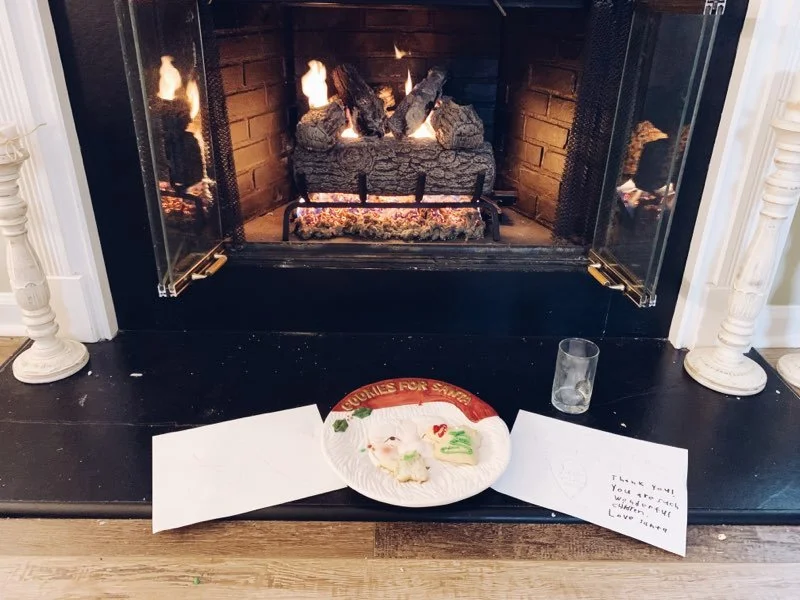telling kids about santa
*A NOVEL WAY TO TELL CHILDREN ABOUT SANTA*
For many of us as children, finding out Santa wasn’t real was our first heartbreak. Perhaps it wasn’t dramatic for everyone, but it was a true disappointment for me. It felt like I’d been duped, and it made me question other absurd stories I’d been told (including about God). Most good parents do not want to lie to their children, but we make an exception for Santa because of the magic he facilitates. Something in us knows we are doing it for a *good reason* but we can’t quite articulate it beyond a loving parental intuition, and we struggle with the transition and don’t want to sadden them.
Something I’ve spent a lot of time thinking about and studying is the importance of Rites of Passage in other cultures and how these have mostly been lost in the West. The real purpose of a Rite of Passage is to create a shift from one psychological stage to another. It is meant to open one up to the next stage of maturation, responsibility, and personal and social empowerment. There are natural Rites of Passage, such as giving birth or the death of a loved one, which can either propel us into our next potentials or cause us to regress. The point being is that they are inevitable “shock points” that if “taken” properly, can move us towards a greater capacity for self-actualization. The function of a Rite of Passage is that it successfully moves the psychological and spiritual energy from one container to the next without allowing the energy to “leak” or “spill” out during the shock.
Last year around Christmas time, our oldest daughter Norah was beginning to ask those GOOD questions about Santa. Most parents can probably relate to recognizing when your child is on the verge of figuring it out. I intuited that this was probably the last year she would genuinely believe. I recognized that the “shock point” was coming soon. I decide to take a risk and channel this energy into a conscious Rite of Passage for Norah. It was truly a risk because I wasn’t sure how it would go, but I felt that there was potential to make the “truth” about Santa into something that would facilitate Norah’s growth—both psychologically and spiritually.
Here’s what we did:
1. We put Norah to bed on Christmas Eve believing in Santa. We did our normal ritual. We tracked Santa on the TV. We made him cookies and milk and put them by the fire place. The kids wrote Santa a note. Norah went to bed with the anticipation of Santa coming in the morning. It was important to me that she experienced falling asleep like this one more time.
2. Once we were sure that the kids were asleep, we put our “Santa” costumes on. I bought Santa hats for Jared, myself, and Norah.
3. We then went into Norah’s room with soft bells. To her surprise, we woke her up with our Santa hats on and told her she needed to come downstairs for something special. She was at peak curiosity and attention.
4. We then read her the story of St. Nicholas. I found a book about the legend of St. Nicholas at my local library. She listened about the life of the saint who secretly saved three daughters living in poverty with anonymous gifts of gold coins. She listened about his love for children and the gratitude that poured from the hearts of those he touched with his generosity.
I loved this book. However, it did have a few inappropriate parts I had to skip over. There are many books on St. Nicholas. I recommend this one, but just be aware that you might need to skip a few details. You can purchase this one on Amazon.
5. After the story was over, we gave her a Santa hat. We looked her in the eyes and said, “You’re a Santa Claus now.” At first she didn’t understand and was confused. Finally I said, “Santa’s not real, sweetheart.” It clicked and Norah teared up as she absorbed the shock. We held her as cried for a few moments. And then suddenly, she perked up. “Does this mean I get to eat the cookies??” she asked. “Yes!” And just like that, she shifted into the realization that this secret was hers to keep now, along with all the perks that come along with it.
6. We ate cookies together, Norah wrote a note from Santa back to her siblings, and she helped put their gifts under the tree. We told her we would do her gifts after she went back to bed so that they would still be a surprise in the morning.
7. She was SO EXCITED the next morning to see her gifts and be in on the secret while she watched her little brother and sister open their gifts. She felt so proud to tell her grandparents her secret news that SHE WAS A SANTA CLAUS NOW.
8. To our surprise, Norah thanked us so much for all the gifts “Santa” had given her in the past. She recognized they were from us and she felt loved.
I wanted to share this because I know, as parents, we all want to move our children into the bigger world in a way that leaves them open with wonder, not closed off and cynical. Again, doing this with Norah felt really risky, but it paid off in a closer bond between us…one where she intuitively understood the purpose of our Santa myth in a way that felt sacred…instead of feeling duped and dumb for believing it literally. She is excited and ready to be Santa again this year.
Just because something isn’t literal doesn’t mean it’s a lie. The spirit of Christ animated St. Nicholas. Children recognize that spirit in Santa. That magical spirit is real and can continue to live on in us and our children. It’s not the impossibility of Santa coming down a chimney that makes it magical. It’s the ordinary love of ordinary Santas freely giving from their hearts and others receiving with glee that IS the magic. It originates within. “The kingdom of God is within you.” - Luke 17:21
Share if you found this helpful! Merry Christmas!
(If you enjoyed this, I’m writing more in my monthly newsletter. Sign up at ReturningtoEden.com)





